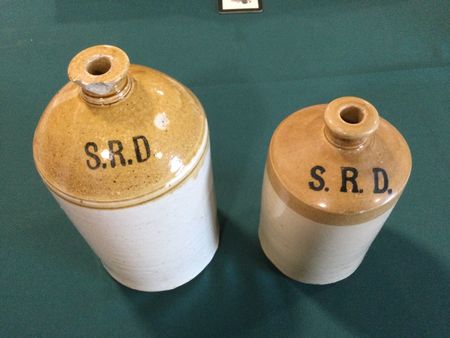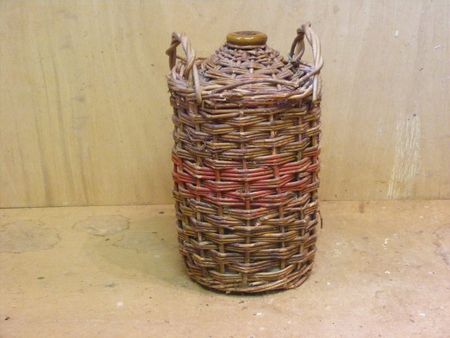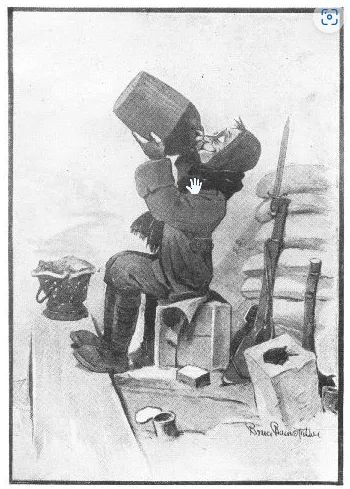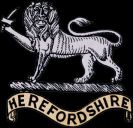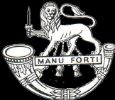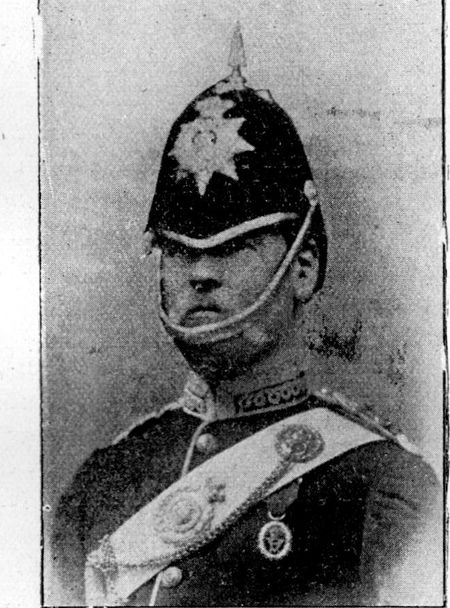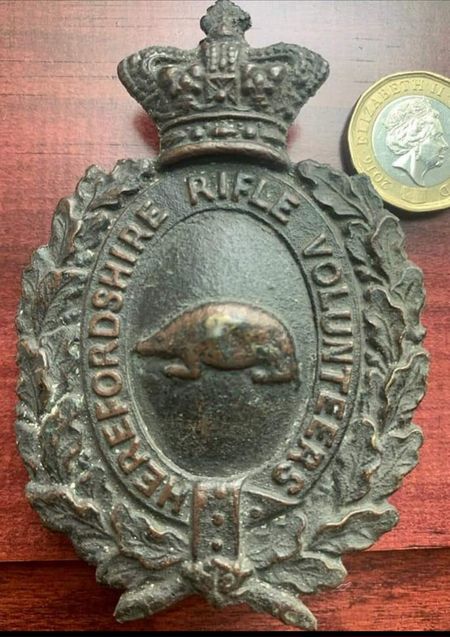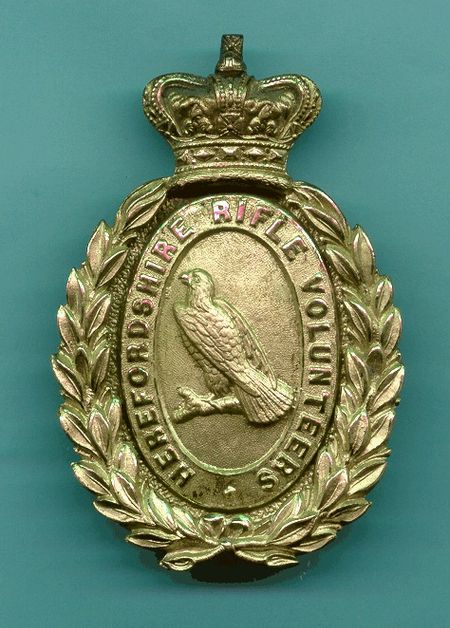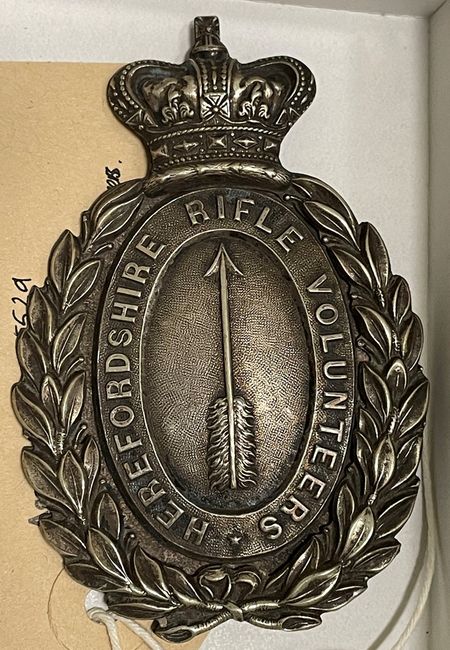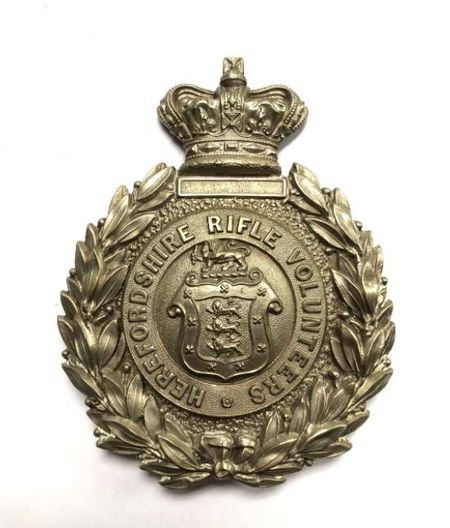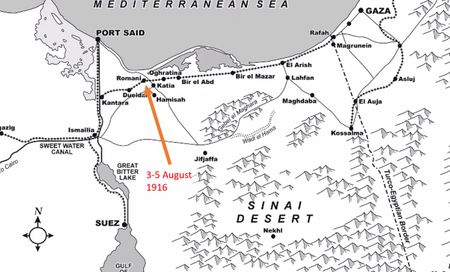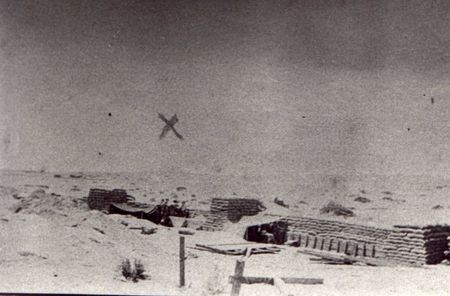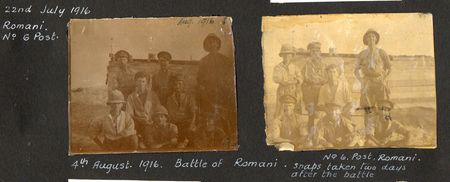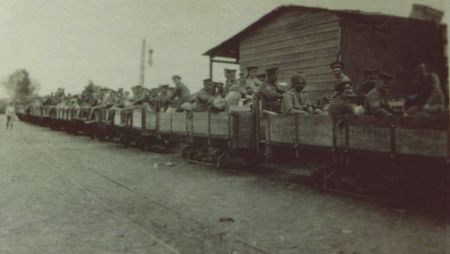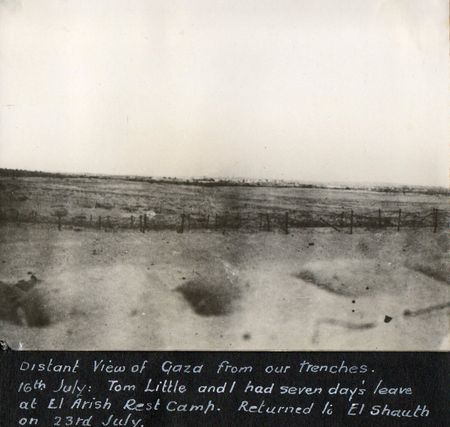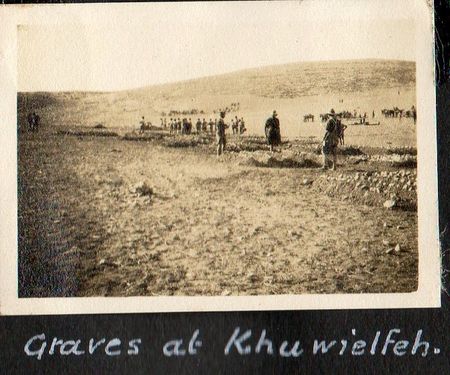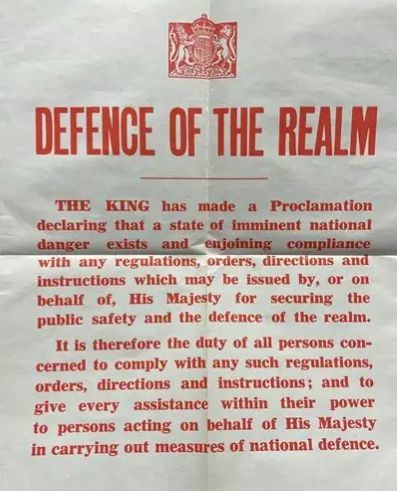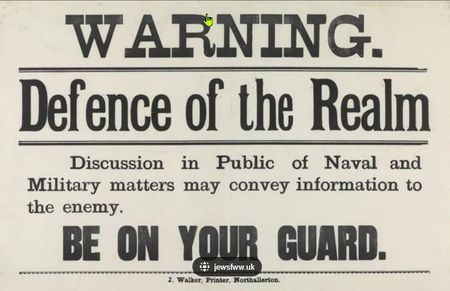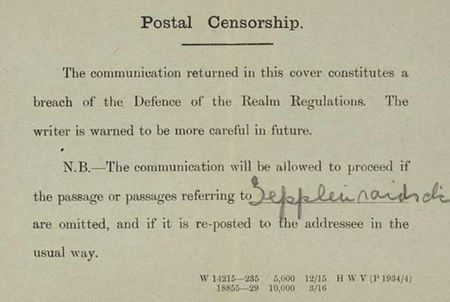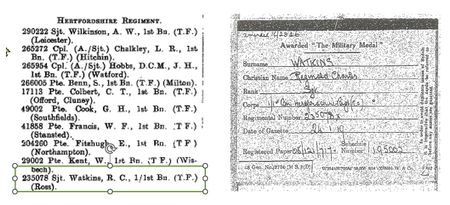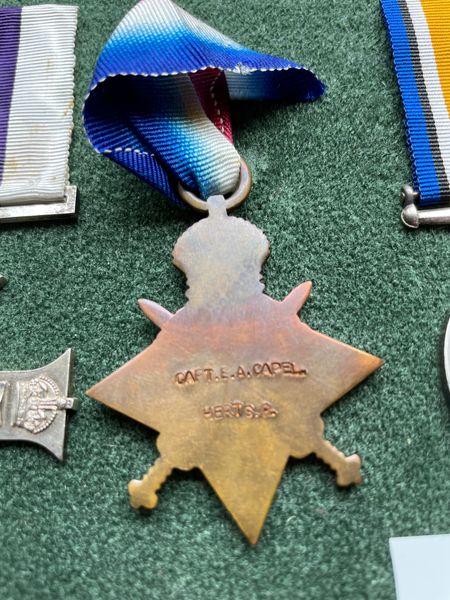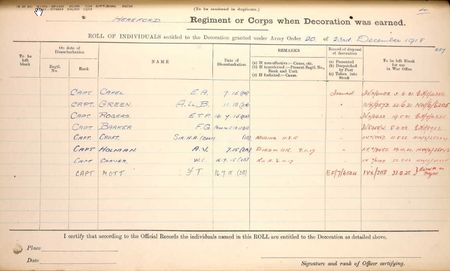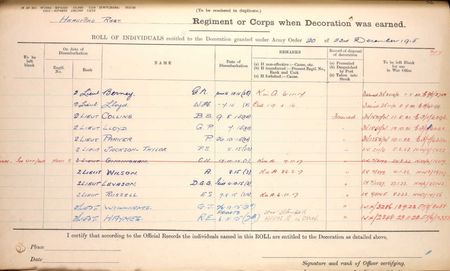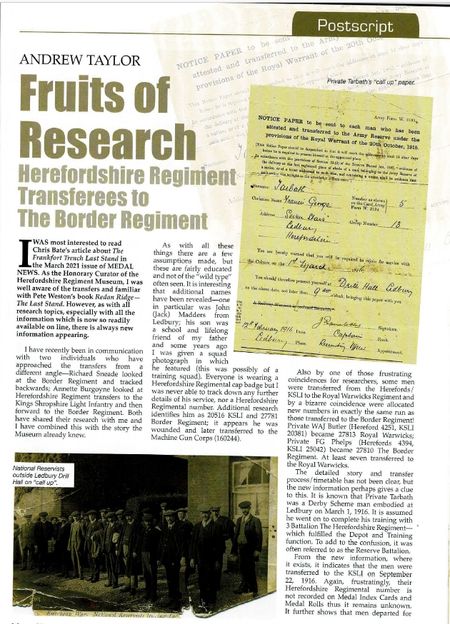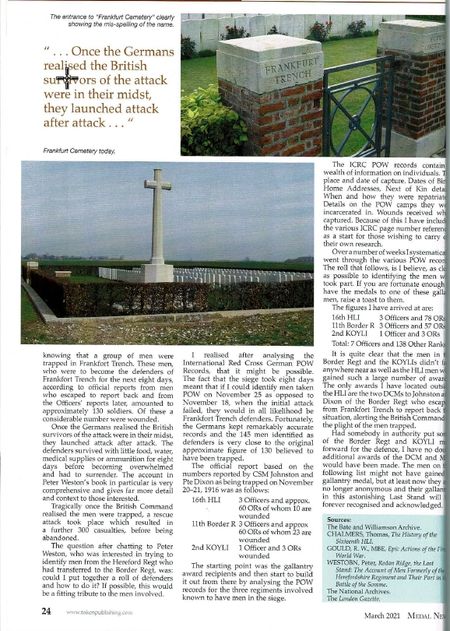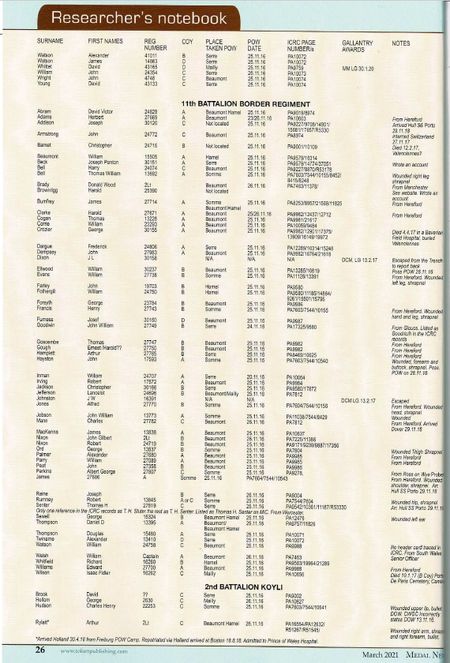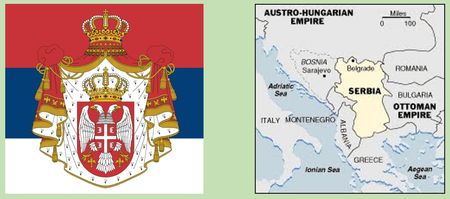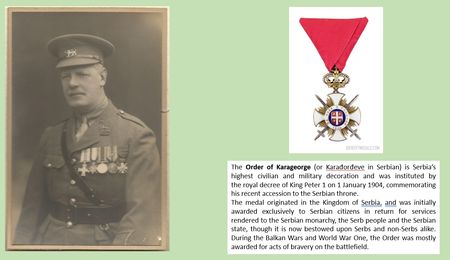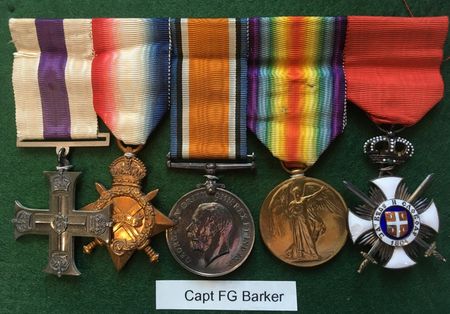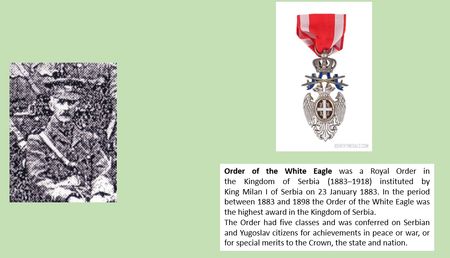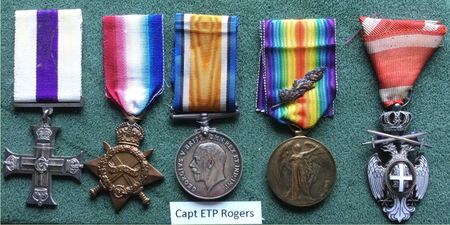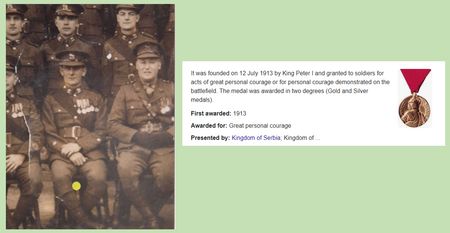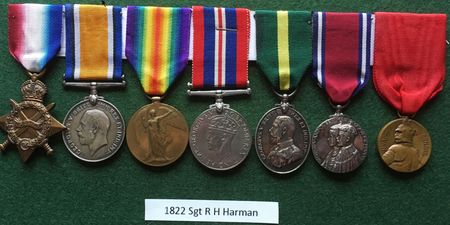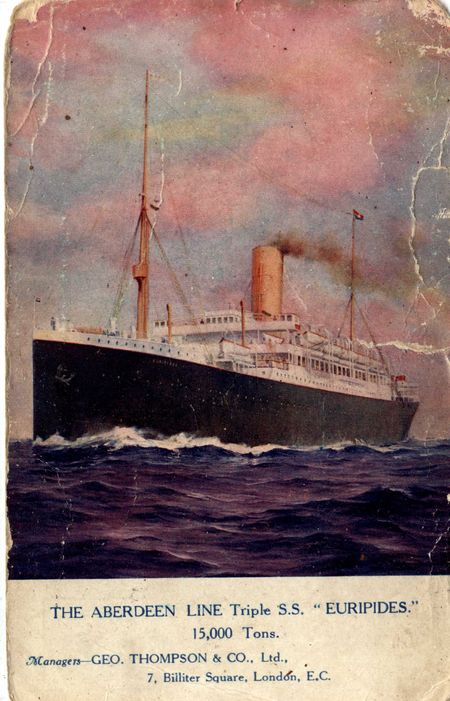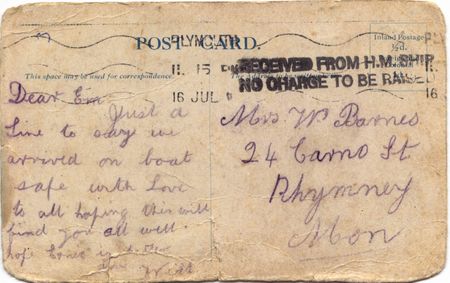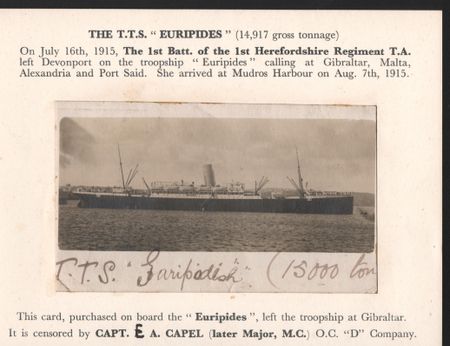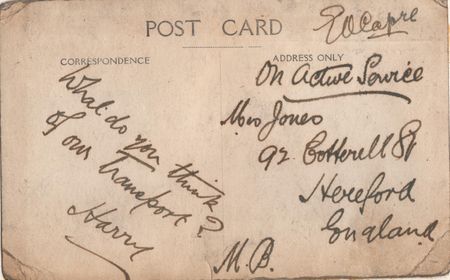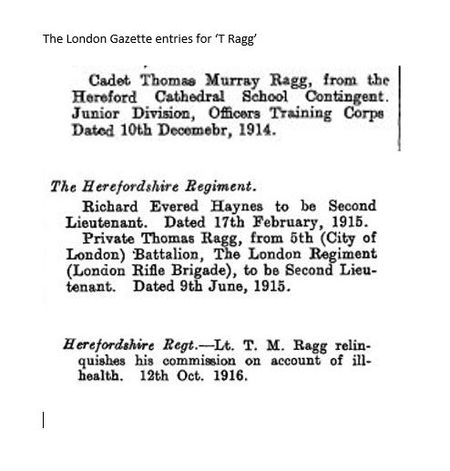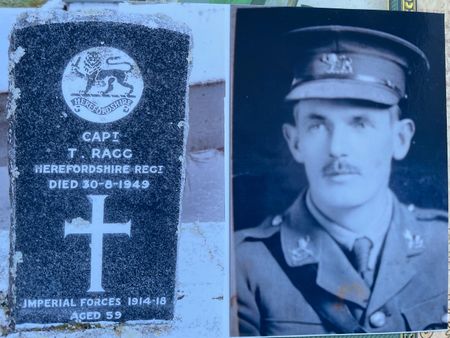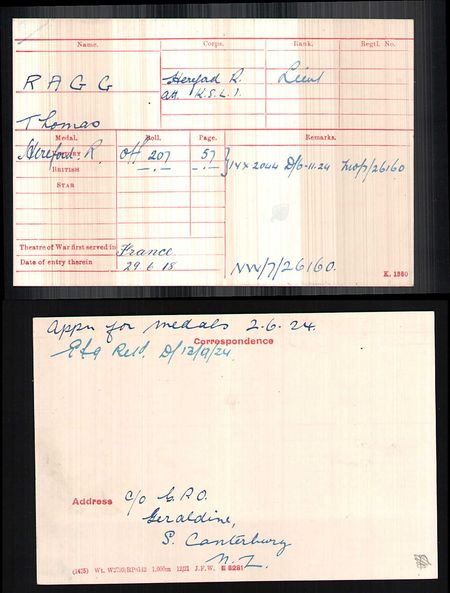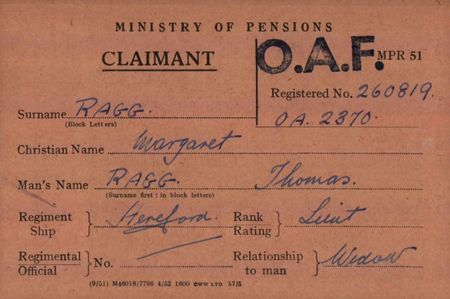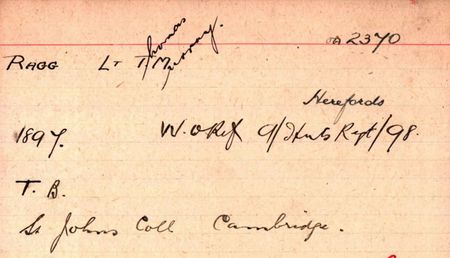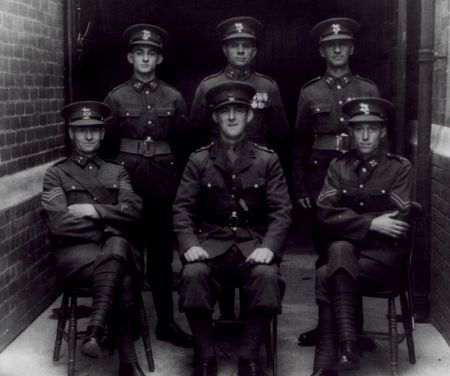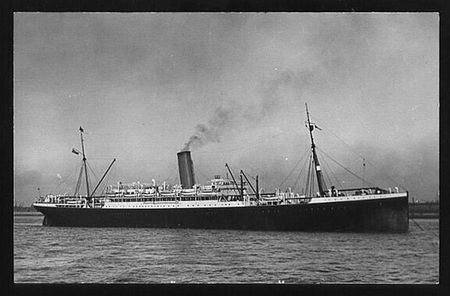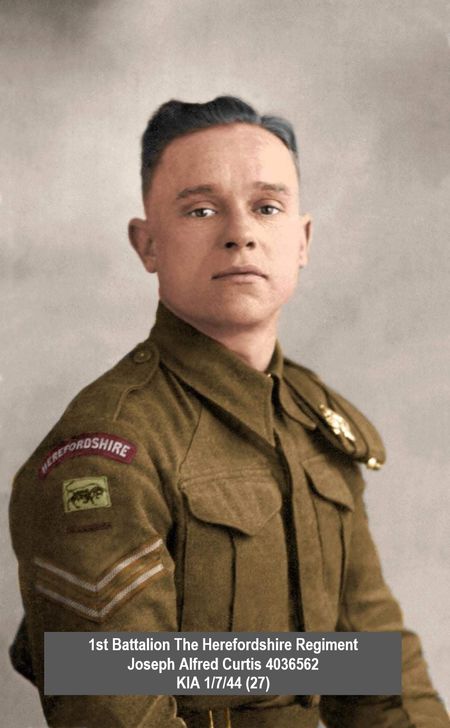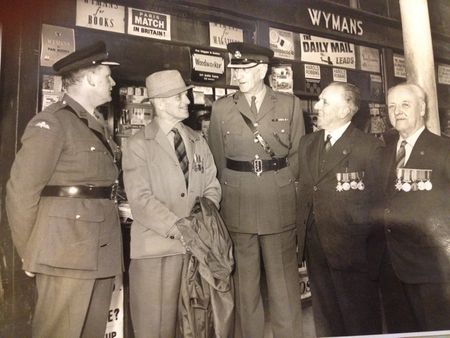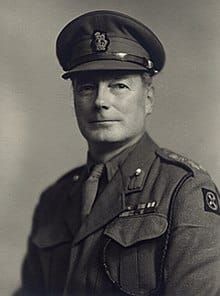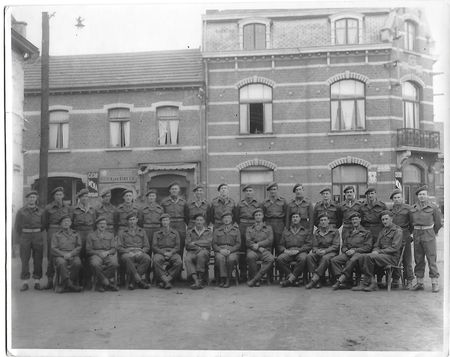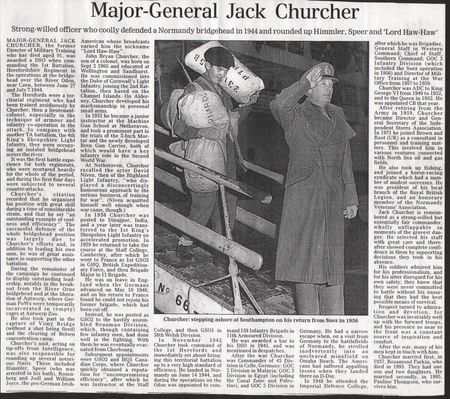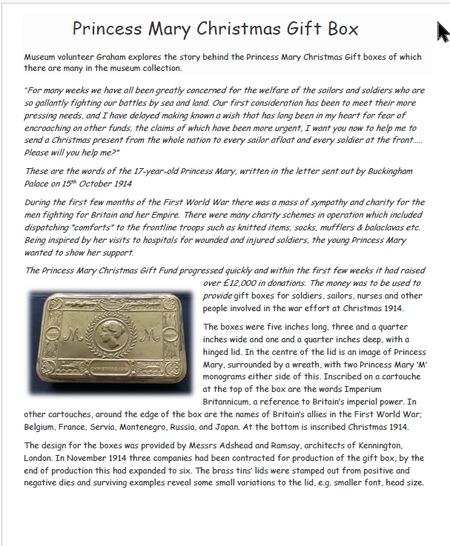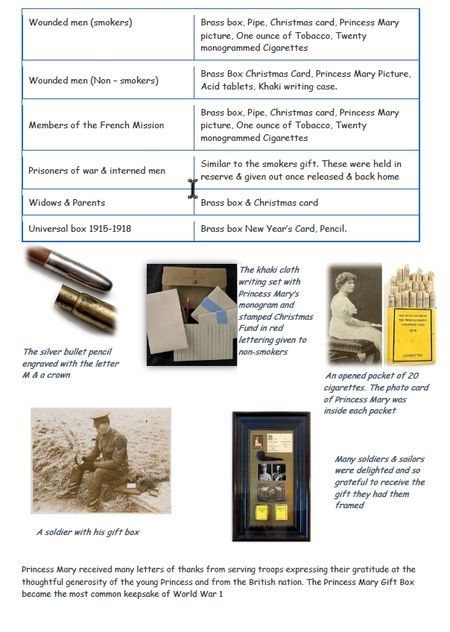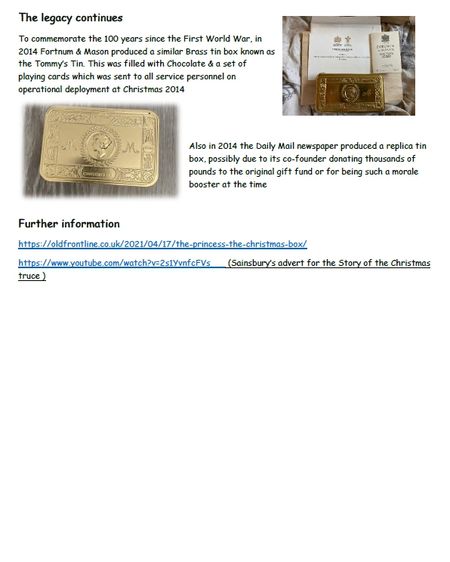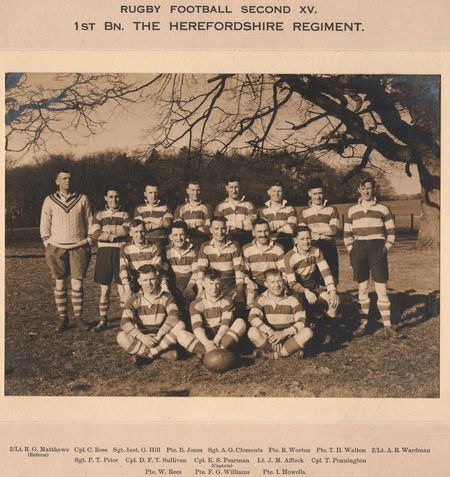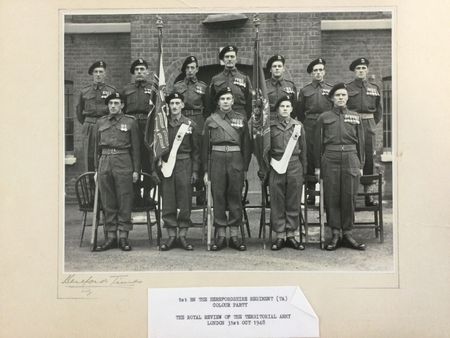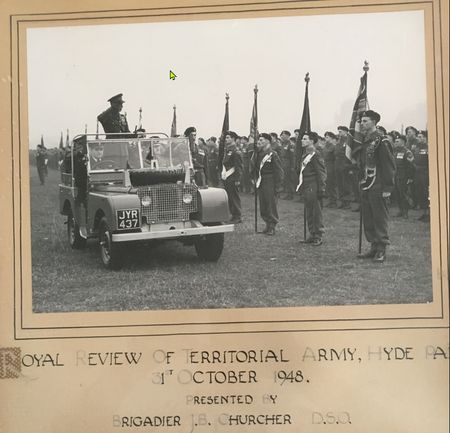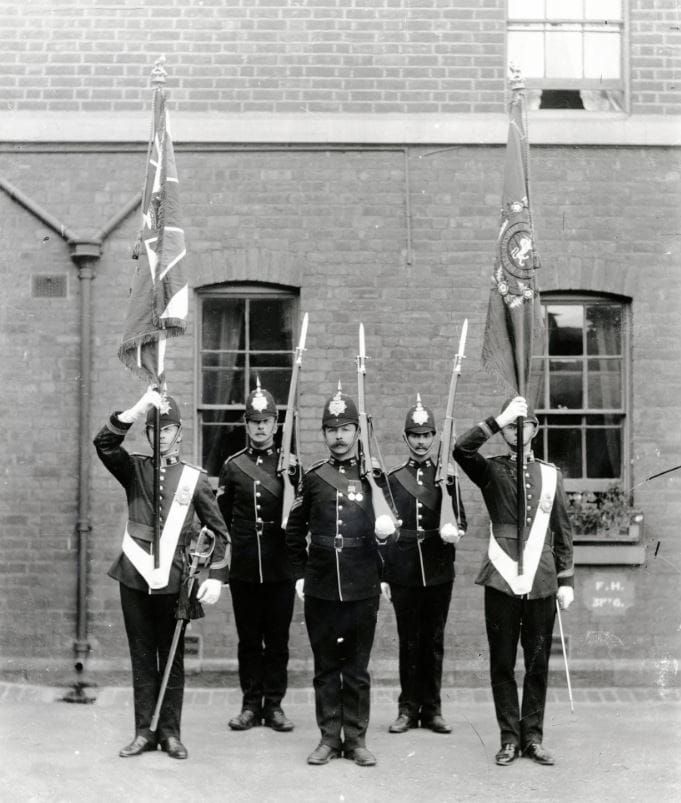
INDEX
Date Name
Jan 26 Voluntary Aid Detachments (VADs)
Dec 25 HRVC Company Badges
Nov 25 'Gaza' November 1917
Oct 25 Defence Of The Realm Act (DORA)
Sep 25 Herefordshire or Hertfordshire?
Aug 25 Redan Ridge - Part 2
Jul 25 Redan Ridge - Part 1
Jun 25 A trio of Serbian awards
May 25 Commissioning Scrolls
Apr 25 Surviving Medals
Mar 25 The Winterbourn Photo Collection
Feb 25 HTS Euripides
Jan 25 Lt T M Ragg - Part II
Dec 24 Wilf Slade arrives in Antwerp
Nov 24 Independent Companies
Oct 24 Floorboard finds
Sep 24 Two Lt T Raggs
Aug 24 Ledbury Contingent for the 1937 Coronation Parade
Jul-24 1st Battalion Officers on HTS Euripedes
Jun-24 Curtis - photos of WW2 casualties
May-24 50th Anniversary Visit to Suvla Bay
Apr-24 Gen Churcher Obituary
Feb-24 Princess Mary Christmas tin
Jan-24 Regtl Rugby Team
Dec-23 Colour Party 1948
Nov-23 Rum jars
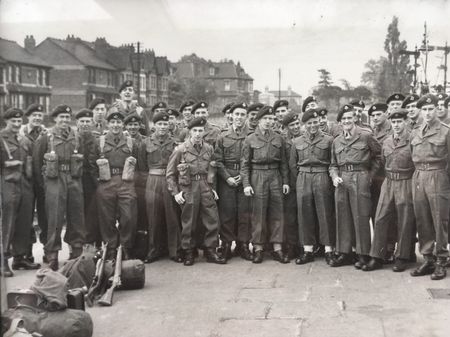
January 2026
Voluntary Aid Detachments (VADs)
The outbreak of war in 1914 saw a massive increase in the size of the Army and Navy. Men came from every corner of the country and every layer of society. The Forces could not cope there were insufficient barracks and support establishments.
The recruits brought illnesses with them – some contagious like measles and soon thousands of wounded would be flooding back to ‘Blighty’.
The established hospitals struggled to cope, additionally men no longer in need of surgical care still needed nursing care – there were no barracks where they could be accommodated and to send them home meant often to a fairly unhygienic and overcrowded home not conducive to their recovery.
At the outbreak of war the British Red Cross Society (BRCS) and the Order of St John of Jerusalem (OStJJ) combined to form a joint war committee. They pooled resources and secured buildings, equipment and staff to set up temporary auxiliary hospitals and support depots.
Country houses and other establishments were offered up/taken over as these Auxiliary Hospitals. They were attached to central military hospitals which looked after the patients who remained under military control. The patients at the Auxiliary Hospitals were generally less seriously wounded than at other hospitals or on the road to recovery (or discharge) and they needed to convalesce. The servicemen preferred the Auxiliary Hospitals to military hospitals because the discipline was far less rigid.
These hospitals became known by the term Voluntary Aid Detachments (VAD), the term also referred to the nurses and volunteer nursing staff that worked in them. Over 3,000 hospitals were established.
Many mothers and sisters of service men wanting ‘to do their bit’ and volunteered to serve as VADs. Family and staff from the houses taken over often served on the management committee or became VADs.
Soldiers in hospital and at VADs were issued with a blue uniform with white facing, a white shirt and a red tie, known colloquially as ‘hospital blues’, so that they were easily identifiable, but continued to wear their own regimental headdress and cap badge. Soldiers in hospital blues were forbidden to enter licensed premises.
In Herefordshire VAD hospitals were established as indicated below:
Location Date Opened Number of Patients
Beechwood May 1915 932
Hampton Grange May 1915 873
Sarnefield Court June 1915 716
Caradoc Court October 1914 443
Kington 1915 416
Upper Hall Ledbury December 1914 275
Hampton Court 1917 ?
High Tree House Leintwardine 1915 ?
Holbrook, Hereford ? ?
There were also non BRCS/OStJJ recuperation centres at Colwall and Bromyard.
A VAD was established at Brandon House, Colwall - see this month's The Camera Returns!

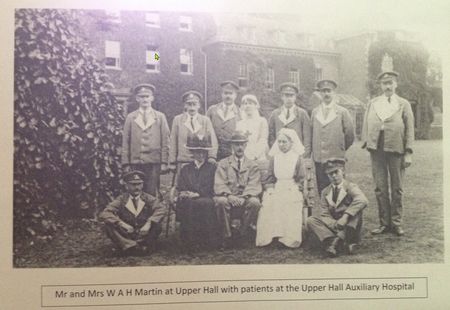
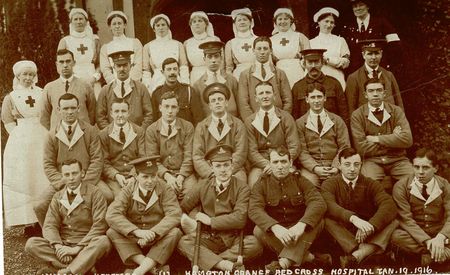
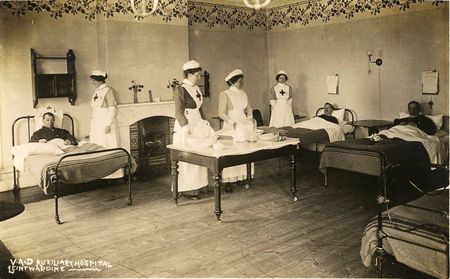
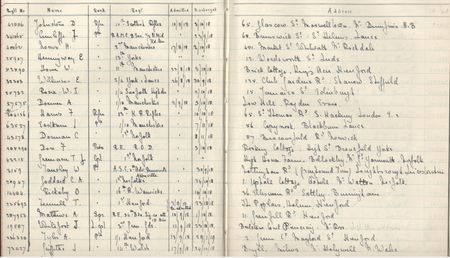
December 2025
HRVC Company Badges
On the formation of the Herefordshire Rifle Volunteer Corps, each company wore an individual badge in the centre of their crossbelt plate.
The badge for every company is not known. It is known that Ross On Wye featured a Badger and Kington a Kestrel. A badge featuring arrow exists but it is not known to which company it belonged to.
If anyone can assist in identifying other company badges the museum would be most pleased to hear from them.
The individual badges were later replaced by a common Herefordshire Rifle Volunteers Corps plate.
November 2025
Gaza November 1917
November 1917 saw The Herefords fighting at Khuwelfeh in the 3rd Battle of Gaza. They suffered their highest number of casualties on any single day of the war including Suvla Bay and the Western Front. They suffered 79 fatalities and scores of individuals wounded.
We will have all seen the news coverage of the utter devastation in Gaza, but it was different in 1917 when the Allied Forces fought against the Turks in this area.
Early in the war had seen the Turks threatening the Suez Canal and the British Empire route to India and the Far East. Egypt was garrisoned and the canal defended. The Herefordshire Regiment as a Battalion in 53 (Welsh) Division were part of this force.
The Turkish final assault towards Egypt ended at the Battle of Romani in August 1916 – the Herefords were in the front line and Maj Capel commanding Number 6 Post was awarded the Military Cross for this action.
This allowed the long advance across the Sinai Desert to start in pursuit of the Turks and the advance to Palestine and beyond. The Sinai was a sand desert, hot and dry with no refuges or settlements of any size end route. The Allies built a narrow gauge railway and a water pipeline to support the troops and the advance could only be made at the pace these support systems could be built.
When the desert was crossed and planning for the assault at Gaza, which would open up the route to Jerusalem could be made.
One role of the mounted Yeomanry was reconnaissance and a party from the Worcestershire Hussars went forward of the desert and reported: One day's outing was very exciting as we had our first peek of the promised land. Rafa is the old frontier between Palestine and Egypt the Turks fixed this because there is nothing but dry desert South of the frontier, with the exception of El Arish. We all knew by our maps that we were crossing into the Holy Land but we hardly expected such a transformation that shortly met our gaze. We had been trekking quietly along for some miles and climbed to a high ridge. When we topped the ridge the view that met us quite took our breath away. Down in the valley lay a large village of white houses surrounded by thousands of trees in bloom beyond those miles of barley everyone was astounded, for it looked the real land of ‘milk and honey’. We had arrived in time, for March is to Palestine what May is to England.
No doubt the contrast was appreciated by all that saw it. No doubt later in 1917 and into 1918 the blossom had set and the area was to be fought over, occupied and passed through by thousands of troops; the tranquility and beauty would have been diminished.
Indeed in 2025 much of the area has been devastated. The Herefords stayed at Rafa, Kahn Younis and other places in Gaza which feature in today’s news broadcasts.
The Allies continued to build up their troops moving them on the railway across the Sinai.
The first and second attempts to breakthrough at Gaza failed – General Allenby replaced General Murray and moved his headquarters forward from Cairo to the eastern edge of the Sinai Desert.
The 3rd Battle of Gaza was successful and opened the road to Jerusalem. The Herefords were part of the Eastern Flanking Force and fought at Khuwelfeh suffering many casualties.
See also this month’s post for ‘The Camera Returns'
October 2025
Defence Of The Realm Act (DORA)
The Defence of the Realm Act (DORA) was introduced just days after the start of the First World War, additional measures were added to it as the war situation progressed.
It allowed the requisition of buildings and resources but also places restrictions on the population - kites were not to be flown, torches and binoculars could not be bought, garden fires were prohibited, church bells were not to be rung - all were considered possible ways of communicating with the enemy. It was also forbidden to feed bread to animals - this an effort to reduce wastage.
There were restrictions on what individuals could say and what could be published in newspapers and written in letters - the 'D' Notice prohibiting publication was introduced and remains in place today! Specific wording was - “No person shall by word of mouth or in writing spread reports likely to cause disaffection or alarm among any of His Majesty’s forces or among the civilian population.”
The economy had to be protected and the melting down of gold and silver was banned. British Summer Time was introduced to extend the working day.
Later in the war, there was concern about drunkenness especially in the locality of the Munition factories, beer was watered down and licensing hours were introduced; pubs had to close in the afternoons - only changed in 1988. A no treating law was introduced.
September 2025
Herefordshire or Hertfordshire?
The people in Herefordshire endure a constant litany of confusion with Hertfordshire. The museum has had phone calls and even people visiting the Museum who then proceed to want to know about the Hertfordshire Regiment – it says a lot for their grasp of UK geography! Take a look at a well known internet auction site and under Herefordshire there are generally quite a few Hertfordshire items!
This confusion also extends to the medal world! I have found at least 4 incidences where the 2 counties have been confused; 3 have been corrected but how many others are there undetected?
The first is the publication of the award of the Military Medal to 235078 Sjt RC Watkins, from Ross On Wye incorrectly attributed to the Hertfordshire Regiment in the London Gazette of 24 January 1919. A correction was published and Sjt Watkins medals are in the possession of the family and the MM is correctly named to the Herefordshire Regiment – but it is unknown if this is a second, corrected issue, his Military Medal index card does show an amendment and is possibly the manuscript amendment of the ‘t’ to an ‘e’. To add to the confusion he later also served with the Suffolk Regiment!
The second is the naming on the 1914/15 Star awarded to Maj EA Capel. He was a pre war member of the Regiment, wounded at Suvla Bay. He was awarded the Military Cross as the Officer Commanding No 6 Post during the Battle of Romani which came under heavy Turkish assault. His medals are owned by a private collector and the 14/15 Star is clearly named ‘Herts R’. I wonder did he even noticed it! The medal roll clearly shows Herefords, other 14/15 Stars from this page have been seen and are correctly named to the Herefords.
The third and fourth cases both feature on the same 1914/15 Star Medal Roll, neither of the medals have been seen. 2Lt Gamingham from the Hertfords in incorrectly included on the Herefords roll and Lt Haymes’ medal entry is annotated ‘stamped ‘Herts’ in error’.
There are probably other cases but it is difficult to search for an error and generally 3 of these 4 were revealed when looking for something else!
July 2025
Redan Ridge - Part 1
The Battle of the Somme in July 1916 raged until November. In the seemingly endless fighting and mud the casualties grew daily. Many units lost so much of their strength that they were no longer battleworthy. In place reinforcements were used up but still more required. Units in UK were trawled for available manpower.
It was in this environment that men from the 3rd Battalion Herefordshire Regiment were transferred to the Kings Shropshire Light Infantry and destined for France. In France they were again reallocated, this time to the 11 (Lonsdale) Battalion The Border Regiment.
Their story is pieced together in this and the next post.
The articles come from the monthly magazine - Medal News.
June 2025
A Trio of Serbian Awards
It will be a surprise to many that amongst the awards made to soldiers of the Herefordshire Regiment during World War One that there are 3 Serbian awards. What most people know about Serbia is its recent history and the Balkan Wars of the 1990s - but how did these First World War awards come about?
In 1914 Serbia was a semi independent Kingdom, part of the Austro Hungarian Empire, but one which was striving for its independence. Serbia was supported in her ambitions by Russia and had fought the Balkan wars of 1912-13 when they took over Macedonia and Kosovo and defeated Bulgaria - indeed the spark that started the First World War was the assassination of the Arch Duke in Sarajevo by Bosnian Serb separatists.
Serbia was supported by Russia and Russia was one of the Allies - with Britain and France - which made Serbia an ally of Britain.
At the outbreak of The First World War Austro-Hungarian and Bulgarian forces attacked Serbia and bombarded Belgrade - Serbia was seen by Germany as important territory to achieve their aspiration of the Berlin to Baghdad railway - because of its importance to the Central Powers it was equally important to the Allies to deny the German ambitions.
The Allies pursued the Salonika campaign hoping to relieve some of the pressure on Serbia but to no avail and the Serbian Army was cut off and escaped through the mountains to Albania, where they suffered severe losses, eventually being evacuated to the island of Corfu. The Serbian Army then rejoined the Allies at the port area of Salonika and eventually in 1918 the Serbian Army with Allied support defeated the Bulgarians. It is difficult to be exact regarding Serbian casualties but they were perhaps as high as 400,000.
It was, and still is the practice of countries to issue medals and decorations to their Allies. The exact protocols are not known, and exact circumstances surrounding the award also not known - in some cases it seems to have been by unit ballot.
Countries also made awards where there appears to be no direct link - in the case of the Herefordshire Regiment, they did not serve alongside Serbian troops nor in the Salonika theatre and again the process for the award is not known.
Overseas awards were however published in the London Gazette and all 3 Serbian awards to the Herefords were gazetted in February 1917 in a list including awards and decorations from several Allied countries. The awards had been mentioned in the War Diary on 10 September 1916. And the award is probably as a result of the Battle of Romani in July, where the Battalion was involved in repelling the final Turkish attempt to invade Eastern Egypt. Post Number 6 held by The Herefords bore the brunt of the assault and Capt Capel was awarded the Military Cross. 16 soldiers were killed and one officer and 23 soldiers wounded.
The Hereford men that received Serbian awards were:
Captain Francis Guy Barker who received The Serbian Order of Karegeorge 4th Class. It is not entirely clear what the UK equivalent would be but probably it lies between Military Cross/Distinguished Service Order.
Capt Barker had been born in North Wales in 1875 and joined the Herefordshire Regiment in 1912. He was mobilised in 1914 and served at Suvla Bay where he was evacuated ill. He was awarded the Military Cross in August 1917 and his medals are held by the Regimental Museum. He retired as a Major in 1924. He was a solicitor and died in Hereford in 1943.
The second was Captain Edward Thomas Percy Rogers who received The Serbian Order of The White Eagle 5th Class. Again it is not entirely clear what the UK equivalent would be but probably the Military
Cross.
Captain Rogers had been born in London in 1872, educated at Haileybury and joined the Herefords in 1911; He was mobilised in 1914 and served at Suvla Bay where he was evacuated wounded. He was severely wounded in July 1916 and was retired as a result of wounds as a major in January 1919 and awarded the Silver War Badge. He had been recommended for the Distinguished Service Order in November 1915 for services at Suvla Bay and awarded the Military Cross in January 1919 and Mentioned in Despatches in September 1916. His medals are in the possession of a private collector.
The third was 1822 Private Richard Henry Harman he received The Serbian Gold Medal for Bravery - there was also a silver medal and the gold medal equates to the Distinguished Conduct Medal.
Pte Harman was born in Hereford, it is difficult to determine exactly when - there are 2 Richard Harman’s in the 1901 and 1911 census - and at times our Richard Harman adds the middle name Henry and George or both! Even his 1914/15 Star and entry in the London Gazette for the Serbian Award spell his surname wrong as Harmar.
However we know he enlisted in 1914 and served at Suvla Bay. He re-enlisted in the reformed Herefordshire Regiment in 1921 - getting a third Regimental number. He attended every camp in the 1920s and 30s and was part of the Regimental route lining party for the 1937 Coronation. He was mobilised in 1939 on the outbreak of the Second World War, but found to be unfit for overseas service and transferred to the 9th Gloucestershire Regiment. He was discharged in 1943. His medals are in the
possession of a private collector.
Herefordshire soldiers also received honours from Russia, Egypt, Romania, France and Belgium.
May 2025
Commissioning Scrolls
When individuals are Commissioned into the United Kingdom's Armed Forces they hold the Monarch's (King's of Queen's) Commission and are issued with a Commissioning scroll which authorises this.
The Museum holds a selection of Commissioning scrolls including: those issued to The Herefordshire Rifle Volunteers; one issued to a Captain for a Temporary Commission in the Volunteer Force during the First World War; a rare scroll issued by Edward VIII.
The Museum would be pleased to see a Commissioning Scroll issued to the Herefordshire Light Infantry which could be signed by either King George VI of Elizabeth II.
Warrant Officers were issued with a Warrant.
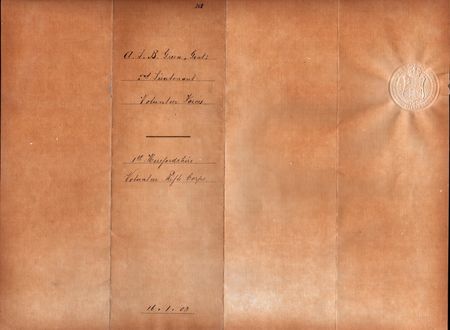

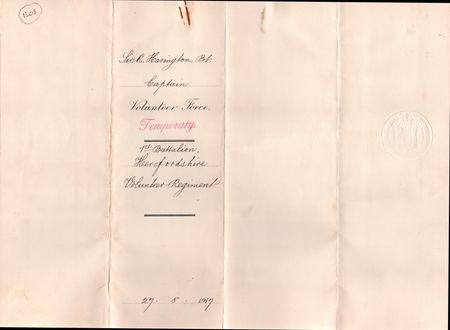
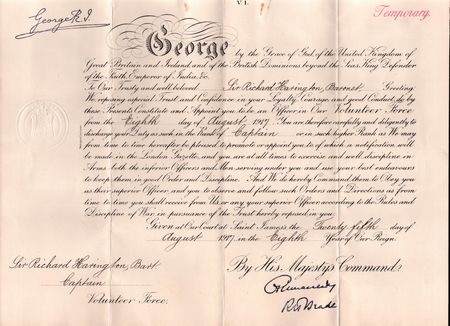
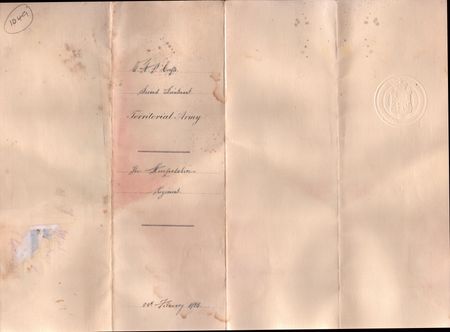

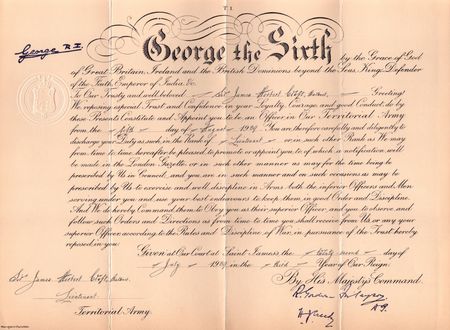

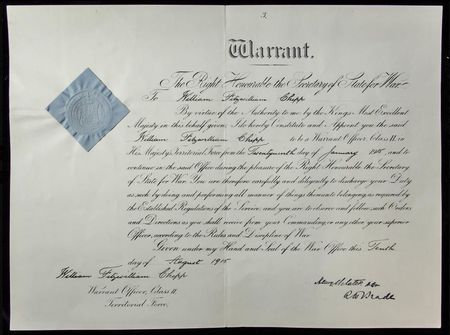
April 2025
Surviving Medals To The Herefordshire Regiment
For over 20 years the Museum has recorded all medals to the Regiment which it has become aware of. These have existed with the recipient, with families, in private collections, auctions and catalogues; ownership details are totally confidential.
To date over 850 groups to the 36th Foot, The Rifle Volunteers, The Regiment and the Herefordshire Light Infantry, the Home Guard and the Army Cadet Forces have been recorded. For the First World War Memorial Plaques and Silver War Badges are also recorded.
The majority of the medals are for the First World War - 640 groups - as these medals were all named and are therefore attributable; Second World War medals are not named.
The groups are many and varied - often the recipient had additional service outside the Herefords that included medal entitlements so that groups include RAF and Police medals, as well as campaign medals for which The Herefords have no entitlement eg; WW2 Italy and Africa Star and Korea.
There are UK and overseas gallantry awards (DSO, MC, DCM, MM, MiD, Serbia, Egypt, France & Belgium) as well as civilian awards (CB, CBE, OBE, MBE, BEM, Order of St John).
Medals include 'campaign medals' - the Military General Service Medal for service in the Peninsula Wars (36th Foot), Crimean War Medals, Queens South Africa Medal (Volunteer Service Coy, HRVC with 2 KSLI), First and Second World War Medals (Herefordshire Regt), Korea, and the General Service Medal.
Many men went on to complete long periods of service and long service medals for Territorial service, police service, St John Ambulance service and Cadet Force service are all included.
On the centenary of the landing at Suvla Bay the Museum aimed to put on display 100 medals groups of men that served at Suvla Bay. These groups all include the 1914/15 Star as the only place the Herefords qualified for this medal was at Gallipoli. 246 1914/45 Stars are known to exist from a total of 1,034; the museum gathered 113 of these to put on display.
Whilst all the medals are special there are a few favourites!
The Territorial Force War Medal (TFWM) is the rarest medal of the First World War - just 30,000 were issued as apposed to 6,400,000 British War Medals. It was awarded to men of the Territorial Forces who volunteered to serve overseas at the outbreak of war but did not in 1914 or 1915 but did later. The Herefordshire Regiment received 53 TFWMs, the location of 16 is known. The TFWM is a specific medal to the Territorial Force and some recipients went on to earn the Territorial Force Efficiency Medal; this is a rare combination and 9 exist to the Herefords - the location of 5 of these groups is known.
The database has been used to inform descendants and in a few cases their ancestors medals have been shown to and handled by those descendants.
The Museum would be pleased to receive details of any Herefordshire Medals that exist to add to this database.


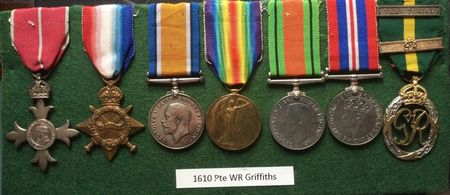

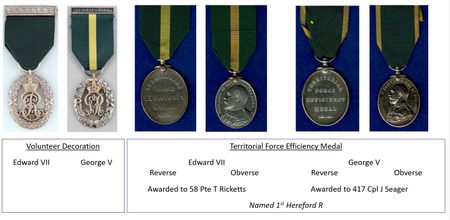
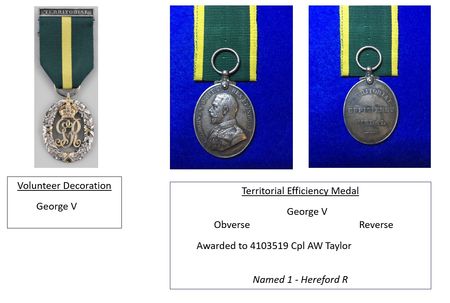
March 2025
The Winterbourn Photo Collection
This month’s feature is the Winterbourn photograph collection.
Thomas Winterbourn was a photographer who worked from his Broad Street home in Leominster between 1870 and 1922. His images cover a fascinating period focusing on local events and people covering the late Victorian era and the traumatic period of the First World War.
The collection came into the hands of the Herefordshire Libraries and consisted of hundreds of glass negatives, not all of which were in good condition. Herefordshire Libraries then then set about conserving and cataloguing them. Amongst the collection were over 200 photographs of military
subjects and the Museum was asked to assist in identifying them. Many could be classified by date, uniform and badges, a few were named and in very few the subjects were recognised, but most remain unidentified.
The majority of the military photographs covered the period of the First World War – they covered individual portraits, family groups, weddings and many showing soldiers in hospital blues – presumably the subjects were convalescing in the Voluntary Aid Detachment (VAD) hospitals established in the county. The studio contained props which feature in many of the photos – the rustic bench, the
patterned floor covering and various chairs and backdrops.
Full details of the collection are available on the Herefordshire Histories website: https://herefordshirehistory.org.uk/

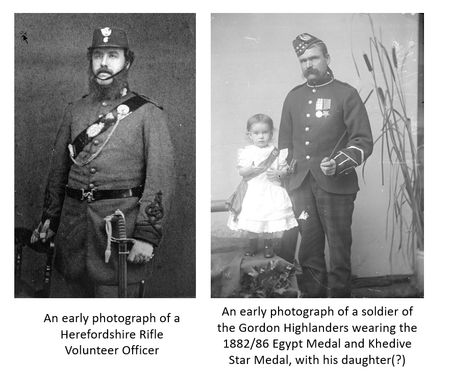
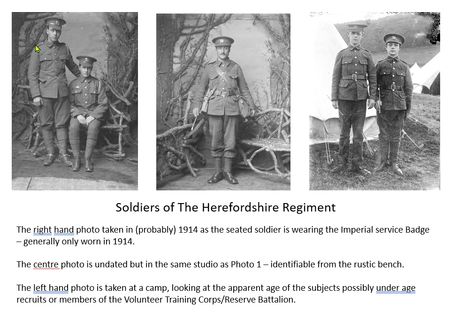

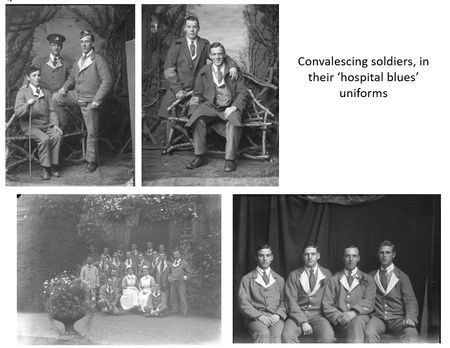

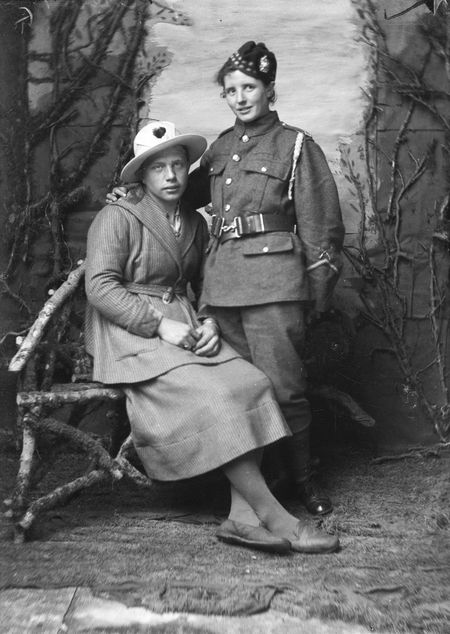
February 2025
HTS Euripides
The Then picture shows Hereford Sector of the Home Guard; the exact date is not known but thought to be later during World War 2 as ladies feature in the ranks. They were recruited for admin and radio duties.
In the rear row, 6th from the left is Sgt Ernest Perks who had served, as a signaller with the Herefordshire Regiment throughout the First World War.
St Ethelberts Almshouses are in castle Street Hereford next to the Castle House Hotel.
January 2025
Lt T M Ragg - Part II
Further to the September post regarding ‘2 Lt T Ragg’ further information has come to light regarding Thomas Murray Ragg.
In November the museum was given 3 letters written by Lt Ragg. These were written to a school friend of his from Hereford Cathedral School where his father (Revd Preb William Henry Murray Ragg was a master and headmaster (1898-1912)) and were donated by the friend’s son.
The handwritten letters have been transcribed and are reproduced in full below, the first when he is en route to Gallipoli as a reinforcement arriving on 26th October, his letter of January 1916 written from hospital in Egypt well illustrates his time at Suvla and ‘the storm’, and the 3rd letter is written in December 1917 when he has been medically discharged from the Army.
Letter dated 17 October 1915 written on board the RMS Scotian somewhere in the Mediterranean
My dear Thompson.
Here I am at last, while on the way to see something of the war. I'm afraid I can't tell you any very interesting news; though I have plenty, on account of the censor.
I left home last Monday. I could hardly believe it is not a week ago I went to Bedford and then up to town for a farewell dinner. We had a great dinner at the Groc (?) and then went to a theatre afterwards. Amongst those present were George and Tom Millyard and the Colonel. They all gave us a fine send off. We stayed the night at the Paddington Hotel but had not time to go to bed.
We left Paddington for Devonport by a special at 8:15 and got down to the docks right by the ship at 2:00 in the afternoon. And went straight on board but didn't sail till 6:00 the next morning. There was a fine show of men of war in the harbour and the whole scene was a very grand one, but the rather sad. Two torpedo boat destroyers accompanied us for the first 160 miles, one on each side a little in advance. Since then, we have been without escort. Our course has been very strange - but more I may not say. We did not go into the Bay of Biscay at all, but we had a pretty enough time of it for a day or two out in the Atlantic however I have proved a very good sailor and have enjoyed the voyage very much so far.
We first sighted land after our departure last night. The land being first Morocco and then the Spanish coast; this was about 11:30pm. Our entrance to ‘Gib’ by night was very impressive, though it was a pity it was dark. There were simply hundreds of searchlights playing about, and warships nosing from one to another and enquiring who we were. We ought not really to have stopped there at all, but we were told in morse by a destroyer to go into the harbour and receive further orders and have papers examined. Thereupon we slowly made our way in, running the gauntlet of hundreds of glaring searchlights, and at last, at 2:00am this morning, dropped anchor in the harbour, from which glared forth rows of searchlights. Almost immediately a pinnace came along with a naval officer on board to enquire who we were and to examine us. The result of his examination being satisfactory, we had our orders signalled to us, from the Governor's headquarters on the top of the rock, whereupon we started off again at about 3:30am, again being thoroughly examined by searchlight.
At 6:00 this morning there was no land insight but this afternoon we sighted the Balearic islands on the port side and the North Coast of Africa on our starboard side, the Mediterranean is like a duck pond. The weather is simply grilling. We hope to reach Malta on Wednesday and have a day ashore, and I expect this letter will be posted from there. Then we expect to go to Alexandria and from there to Suvla Bay, Gallipoli, but we do not really know where we're going.
My address will probably be:
Lieutenant TM Ragg, 1st Herefordshire Regiment, 105 Infantry Brigade, 53rd Welsh Division, Mediterranean Expeditionary Force.
Do write if you can, for you have no idea what letters mean to us and how often and carefully they will be ??? nothing is too triffling.
Now goodbye and good luck
Till we meet again
Yours ever
Tom Ragg
Letter dated 6 January 1916 written from 17th General Hospital Alexandria. He had been evacuated from Suvla Bay on 30 November.
Dear Thompson,
Thank you so much for all your letters and the photo of yourself which I believe I never thanked you for before. I'm afraid I have been very slack in writing to you. Especially as you have been so good in writing to me. I wrote to you for Christmas but I’m afraid you will never get it for with many others it is probably now at the bottom of the Mediterranean having gone down in the ????.
Well, I have been having a very slack time of it lately, having been in this hospital since December 4th, suffering from frostbitten feet. Since I wrote to you last from the trenches at Suvla in November, many things have happened and I have had. such an experience as I never wish to have again. Up to November 28th things went fairly well. Though we were all feeling pretty done up having been in the front line trenches a month without being relieved. Through our section of the trenches there cut at right angles. A dry bed of the stream which all passed through the Turk trenches 100 yards further up. Both we and the Turks had us strong sandbag barricades built across it from one bank to the other about 9 feet high, so that our parapet line should be unbroken.
Now, on the 29th November, soon after it was dark, we had a terrific thunderstorm, lasting for about two hours; a real tropical thunderstorm and all of a sudden at about 8 o clock we heard a sort of raucous noise which grew gradually louder and louder and then we saw that the stream was coming down, but that the water had been held up by the Turks’ barricade and was now rushed along in a wave about 6 feet high. It came straight against our barricade, broke it down and gushed on, carrying away two bridges that the engineers had built further down. The stream rose 9 feet high and all the trenches were six feet deep in water and slime. I, like many others, was up to my trunk in this lovely slime and had to be pulled out by the more fortunate ones who had got out of the trench.
The rest of the night we spent lying down outside the trenches, in the open and not feeling very safe or happy. For many. All our rifles were wet and useless, and many had been swept away, and to make matters worse, none of us having our overcoats it began to hail. When at dawn, the next morning the water had gone down a bit - only 4 feet high now. We went back into the trenches again, but we were surprised to see the Turks still sitting on the top of their parapets. But we soon taught them that it would be safer for them down in the trenches.
That day was the most miserable I have ever spent; it snowed hard all day. There was a bitter cold northerly wind. We were up to our thighs in water all day all we had to eat was 2 biscuits each. The rest of the ??? all our kit and belongings having been washed away. Dead bodies of Turkish men and mules came floating down and got between our legs. It made an awful stench. That evening, our Battalion was relieved by the Lovat Scouts, but I with the Machine Gun had to stay behind another night while the relief took place.
That night it snowed continuously. I was bitterly cold. Almost worse than the night before, but we managed to get through it alright and were relieved the following morning. I found, however, that I couldn't walk because my feet were so bad and had to be carried to the hospital on the beach of Suvla Bay near the Salt Lake where I found many of our regiment; both officers and men, and hearing from them that our Brigade, which had been 3000 strong, now only mustered 150 men and 4 officers. Our regiment numbering only 80. Of the rest many had been drowned or had died of exposure, and many were in hospital.
After four days I was taken aboard a hospital ship, then sailed for Alexandria where I was put in this hospital and still I am here. I find that it is very awkward to be without clothes. ??? in a strange town but I am gradually overcoming such difficulties. Yesterday I was allowed out for the first time, dressed in clothes borrowed from 5 different people in my ward! I must have looked a funny object. This ward I am in holds 40 beds, but there are only 10 of us in it at present and we are very happy. The whole hospital is a huge building holding 1600 patients. Well, I must stop now, so cheerio and best of luck for the coming term.
Yours ever
from Ragg.
PS. I have just heard that there is just a chance that I shall be invalided home and that very soon. And so hardly know what to do with myself. For excitement. I don't know what I should do if they finally decide that it would be better for us to stop here.
PS. 9th January 16. I now hear that it is certain that I am coming home and by the next boat, which will probably leave some day this week. Hurray.
Letter dated 18 December 1917 written from home in Tenbury Wells.
My dear Thompson,
Very Many thanks for your letters and heartiest congratulations on your football colours. Please excuse the writing, for I'm sitting out in the garden in about 4° of frost, wrapped up in countless rugs, overcoats and hot water bottles, and with a thick pair of gloves on. Awfully difficult to write with thick gloves on and with frozen hands. However, if you can't read this, burn it.
You would have broken up now I expect and be at home or on your way home. I hope your singing at the end of term went off successfully. No doubt you are glad it is over.
I had a letter from Hodson this morning. He has left the RAMC and is attached to the 26 Training Reserve Battalion till he joins a ?? Battalion with a view to getting a Commission. He is stationed at Pirbright near Bisley. If it's anything like Bisley. I don't envy him.
If I'm well enough I hope to pay a visit to your island next month I should be staying with an aunt who has taken a house at Ventnor, and I'll probably be going on or about the 10th of January 18. If you're at home, then I hope you will come over and see me, unless you have got too many other things to do. I have never yet been on the island and am very keen to get there if possible for a visit. Though my limit for walking being half a mile a day; I'm afraid I shall not be able to explore its beauties as I would like to. It's such a devil of a long journey from here too. I was awfully glad to hear such good news of Hopewell, he seemed to be getting on wonderfully well.
I can't remember whether I have told you before, I don't think so, that I had to go over to Worcester for a pension medical board about a month ago and saw Mr Hughes, who is a master at King's School now, and Minor Canon in the cathedral he came to dinner with me at the hotel where I was staying and we afterwards went to his digs which are very cosy and comfortable. At the board they gave me a pension of £175 for the next year, the maximum for a Lieutenant which is not too dusty. Poor old WL Carver; I was awfully sorry to see that he had been killed. He was a fine fellow and officer. We shared a dugout for some time on the peninsula, and afterwards were in the same tent at the Beach Hospital sharing rum and milk, the only food available for 3 days. We also shared the same bunk on the hospital ship to Alexandria and were in the same ward at the hospital there, but he was only there for a week with slight frostbite and dysentery. I've only seen him once since when he came to visit me a month after he had left the hospital, he was in the same company as I when I first joined at Hereford in September 1914.
My mother heard from Miss Martin the other day. Do you remember her at school at Hereford? She says that OW Richards is an awful fellow and gives lots of trouble. Apparently Cook, who is the mainstay of the house, will have to join up before next term. Forward a King’s fellow, 6 foot 3 inches in height, so she says, has been down and had a tremendous lot to say for himself. There is a little brother Forward coming to Hereford next term.
There are apparently 54 boarders in the house and 20 in the Henson's house and Mrs Felton is going to start a house next term. That is all the Hereford news I know, but I'm expecting to get my Herefordian soon. Poor old Apperley’s son and heir died the other day. By the way, I saw in the Times about 3 weeks ago an announcement of the marriage of RM Dunkerley - he can't be more than 21 at the very most, I should think.
Well, I must stop now, I'm going to go in and try and thaw a bit - cheerio and best Christmas wishes.
I shall hope perhaps to see you next month.
Ever yours
Tom Wragg
The September account hints that Lt Ragg did not serve overseas – this is incorrect but was based on the fact that there is no record of any First World War Medals being awarded to him – but it is clear he served at Suvla Bay and therefor has a medal entitlement – 1914/15 Star, British War Medal, Victory Medal and also the Silver War Badge. Officers had to apply for their medals – it would appear that
Lt Ragg did not apply for his – the reason only to be guessed at!
After the war he followed the occupation of ‘writer and publisher’, he married in 1930 and lived
in Hampstead.
He died in 1953, coincidentally on the 11th November.

December 2024
Wilf Slade Arrives in Antwerp
This month's feature is a photograph of 4105520 Pte Wilfred Richard (Wilf) Slade of the Pioneer Platoon of the 1st Battalion on their entry into Antwerp on 4 September 1944.
Wilf was a pre-war member of the Herefordshire Regiment and was a bricklayer - hence his employment in the Pioneer Platoon.
He was awarded the 1939/45 Star, The France & Germany Star, The Defence Medal, The War Medal and the Territorial Efficiency Medal.

November 2024
Independent Companies
INDEPENDENT COMPANIES
This month’s feature is about the little known Independent Companies formed in 1940 and the fore runner of the Commandos.
In April 1940 each Territorial Division was required to form an Independent Company.
No 1 Coy 52 (Lowland) Div
- No 2 Coy 53 (Welsh) Div
- No 3 Coy 54 (East Anglian) Div
- No 4 Coy 55 (West Lancs) Div
- No 5 Coy 56 (London) Div
- No 6 Coy 9 (Scottish) Div
- No 7 Coy 15 (Scottish) Div
- No 8 Coy 18 (Eastern) Div
- No 9 Coy 38 (Welsh) Div
- No 10 Coy 66 (East Lancs) Div
The companies comprised 3 platoons coming from each of the Division’s brigades. Each platoon consisted of 4 sections one coming from each of the Brigade’s battalions.
Thus the Herefordshire Regiment contributed a section to No 2 (1st Battalion) and No 9 (2nd Battalion) Companies.
The first 5 companies sailed to Norway as ‘Scissor Force’ to join OP AVONMOUTH – the British Expeditionary Force to Norway.
On their return they were formed into Commando units and in October 1940 were termed Special Service (SS) Battalions:
- 1st SS Bn Formed from 1,2,3,4,5,8 & 9 Independent Companies
- 2nd SS Bn From 6 & 7 Coys
- 3rd SS Bn From 4 & 7 Commando
- 4th SS Bn From 3 & 8 Commando
- 5th SS Bn From 5 & 7 Commando
In early 1941 the Special Service Bns were reorganised back into smaller more manageable sized Commandos.
The names of the men and full details of what the Herefordshire section did in Norway is not known. The companies were lightly armed and fought in the rearguard action about Bodo. Eventally being evacuated on 1 June.
No 9 Company did not deploy to Norway, although they did board boats but the sailing did not take place.
Lt Ronnie Swayne, from Tillington Court of the 2nd Battalion was the Herefords officer in No 9 Company, he recorded his experiences and these are available on tape at the Imperial War Museum. He had been Commissioned into the Herefords in August 1939 from ‘Cadet Sergeant – Bromsgrove School’.
Lt Swayne went on to serve with the Commandos and was awarded the Military Cross for the St Nazaire raid (OP CHARIOT) for gallant and distinguished service on Motor Launch 306; his citation reads:
On 28 March 1942, during the Commando Raid at ST. NAZAIRE, France, Lieut Swayne was in command of a Demolition party on board a Motor Launch. Due to the intense fire from the land, it was impossible for this Motor Launch to land the military personnel, and the Naval Commander, after making several attempts, proceeded to withdraw from the River Loire. When they had proceeded some distance, they were engaged at very close range by a German Torpedo Boat.
Lieut Swayne manned all the light automatics under his command, and controlled continuous fire on the enemy vessel. A request to surrender made by the German Naval Commander was totally disregarded and in spite of intense fire from the enemy Torpedo Boat during which many were killed and wounded, the Motor Launch continued to engage the enemy.
After the majority of the naval personnel had been either killed or wounded, Lieut Swayne still kept his men fighting, even up to the point when the Torpedo Boat attempted to ram the Motor Launch.
It was only when all effective fire power on board the launch had been wiped out, that with a handful of men still alive, Lieut Swayne was forced to surrender to the German vessel.
His leadership and his personal disregard for danger was a fine example to those men on board who manned the light automatics in face of far heavier fire power.
During this encounter Sgt Durrant was wounded. Lt Swayne the only unwounded man on board stood up and called out apologetically to the German ship ‘Jaguar’ – ‘I’m afraid we can’t go on’. The ML 306 sank as the survivors were taken on board Jaguar. Kapitan Paul of the Jaguar said to Lt Swayne ‘I must complement you on a brave fight’ Sgt Durrant was awarded the VC, on the recommendation of the German Captain!
Lt Swayne was a PoW for the rest of the war and retired from the Reserve of Officers, Hereford LI in 1963 as a Lieutenant!
He was knighted as Chairman, Overseas Containers Ltd on the 4 December 1979.
He died in Salisbury 29 October 1991.

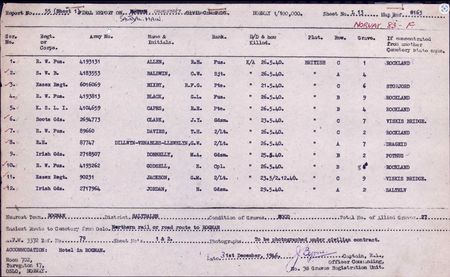
October 2024
Floorboard Finds
This months feature comprises a 'small hoard' of items found under the floorboards of a house in Park Street during a recent renovation. Park Street is to the rear of the Barracks.
The items comprise of a Victorian half penny, 2 musket ball, and very small (dented) pewter cup and a Militia button.
From 1856 to 1908 the Barracks was the HQ of the Herefordshire Militia. It is possible that the occupant of the house was a member of the Militia, or that as there was no accommodation at the Barracks, Militiamen attending for training were billeted in local houses.
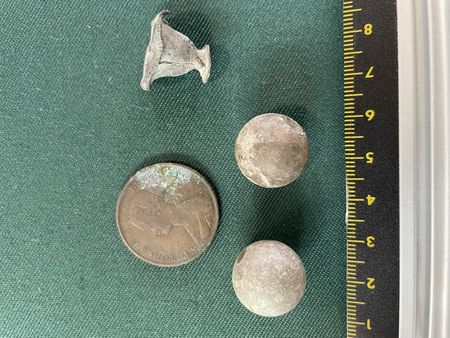
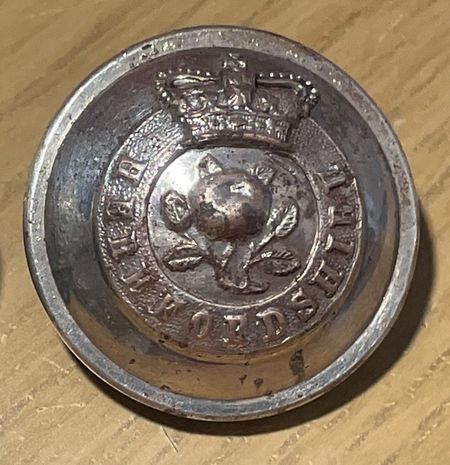
September 2024
Two Lt T Ragg
World One research is challenging at the best of times, yet recently an even more confusing situation has been discovered when 2 officers, both named ‘T Ragg’ were Commissioned into the Herefordshire Regiment.
It is made more confusing by Officers not having personal numbers, and some references having an abbreviated forename or just a single, rather than full initials! T Ragg cannot be a common names and an easy assumption that could be made is that there was only one!
This situation came to light as a result of an enquiry from a family descendent and subsequent research, when the detail given did not seem to fit!
The 2 Raggs acquired their Commissions by different routes - Private Thomas (Tom) Ragg Commissioned from the London Rifles (9 June 1915), Thomas Murray Ragg from Hereford Cathedral School OTC (10 Dec 1914).
A quick look at the 1911 census gives a few more details - Thomas Murray was a pupil at Hereford Cathedral Scool (where his father was a housemaster) and born in 1897 in Norfolk; the other, Tom born in 1890 in Jersey and then living in Hertfordshire (yes Hertfordshire – another opportunity for confusion!) and working as an insurance clerk.
A review of the Museum archives revealed a photograph of the Officers of the 3rd/Depot Battalion - it is undated but since they are wearing the city coat of arms capbadge (worn only until late 1915), some appear with the Terrotorial ‘T’ beneath their collar badges and there is a mix of ‘bright’ and ‘bronze’ cap and collar badges the photo is almost certainly late 1914 or 1915. Lt T Ragg is shown - but which of our T Raggs is he! A photo from the family would indicate that it is ‘Tom’, the photograph is therefore post June 1915.
But what of their military careers ………………..
Thomas Murray Ragg relinquished his commision of account of ill health 12 Oct 1916 - it appears he never served overseas.
Tom’s Medal Index Card indicates he went overseas (France) with the Kings Shropshire Light Infantry on 29 June 1918.
Tom’s family emigrated to New Zealand and Tom suffered from recurring mental health issues (- I suspect what we would now call PTSD) and died in an institution on 30 August 1949.
There are additionally some pension records which to the unwary could further confuse the situation:
An undated card for TM Ragg shows a claim apparently in respect of TB - this would align with his resignation through ill health.
There are several (again undated) cards for T Ragg, including one from his widow Margaret from NZ so for ‘Tom’.
I think this well illustrates the challenges of research and the need to always ‘dig a little deeper’ and not make the quick and easy assumption!
August 2024
Ledbury Contingent for the 1937 Coronation Parade
This month’s feature is a photograph of the Herefordshire Regiment’s soldiers from Ledbury, who travelled to London as part of the route lining contingent for the Coronation of King George VI in May 1937.
The photograph was taken outside the Drill Hall in New Street, Ledbury prior to them moving to Hereford to join up with the Battalion route lining party and moving, by train to London.
Pte Neale had served with The Herefordshire Regiment during the First World War at Suvla Bay, and is wearing the 1914/15 Star, the British War Medal and the Victory Medal. His son, Arthur was one of the first battle casualties of the Second World War when he was shot in the neck in France, in May 1940 whilst serving as a Regular soldier with the Kings Shropshire Light Infantry (KSLI). He was evacuated to England, where his mother was able to visit him, but died shortly after she arrived. His funeral took place in Ledbury.
On the expansion of The Territorial Army in 1939, the Ledbury Company became ‘Y’ Company part of the 2 Battalion The Herefordshire Regiment and served throughout the War as part of the UK defence force. Some individuals did serve overseas; LCpl Bevan served in East Africa and attained the rank of Warrant Officer Class II.
June 2024
Normandy Casualties
Casualty Photographs
Cpl Joe Curtis who served with the 1st Battalion was one of the first casualties of the Herefordshire Regiment after landing in Normandy, he was a member of the carrier Platoon and Killed in Action on 1 July 1944 whilst carrying out a Recce Patrol towards Esquay from the Battalion position in the bridgehead forward of the River Odon in the area of Tourmaville.
Bob Curtis, Joe's nephew has researched his uncle's history, planted and dedicated a tree at the Hill 112 Memorial in Normandy and has started a project to collect a photograph of all of the 11 Armoured Division casualties from the Second World War.
This includes The Herefordshire Regiment and so far 112 of 233 (as of May 2024) have been found.
The full list and photos can be seen at: https://sites.google.com/view/11th-armoured-division/roll-of-honour.
If you can help to locate any more photographs of The Herefords fallen then please contact Bob direct or the Museum curator.
May 2024
Suvla Bay - 50th Anniversary Visit
There has been, and continues to be much attention paid to World War One Centenaries, but what of the 50th anniversaries? When the young men of 1914-18 would have been fairly recently retired, many of them in their late 60s and early 70s, still relatively fit. Overseas travel was less daunting and perhaps attitudes and finances had lead to an environment when visits to the more distant battlefields had become possible.
Such was the case in April 1965, the 50th anniversary of the gallipoli campaign when 3 former members of The Herefordshire Regiment, who had landed at Suvla Bay on 8 August 1915, undertook a visit to Gallipoli. The 3 were led by Harold Slaymaker (72), who had been detached from the Battalion at Gallipoli as a Staff Clerk with HQ 160 Bde, and he later to work for the Foreign Service in many embassies throughout Europe and I suspect he may have been the inspiration behind the tour. The other 2 members of the group were John (Jack) Davies and Thomas (Tommy) Fletcher both 71 who had landed on the beaches on the morning of 8 August, and both were evacuated suffering from wounds and dysentery.
The 3 left Hereford Railway Station and were seen off by The Lord Lieutenant Colonel JF McClean and Lt Col PM Carr - the Honorary Colonel and CO of The Herefordshire Light Infantry respectively – the successor regiment to The Herefords. The intrepid 3 travelled by train and coach via: London, Brussels, Munich, Maribor, Zagreb, Belgrade and Sofia before arriving at Istanbul. There is no indication of how long the journey took, but pre motorway and ‘free’ border crossing and coaches with ‘air-con’, it must have been quite a journey!
These were also the days before common public international phone communication and Harold Slaymaker regularly reported back by telegram.
They attended a reception held by The British Legion (pre ‘Royal’ days), and appear to have met up with a reporter who was recording a piece to be broadcast on the radio programme – from our own correspondent.
April 2024
General Jack Churcher
General Jack Churcher was a regular officer in the King's Shropshire Light Infantry.
In 1942 he was appointed the Commanding Officer of The 1st Battalion The Herefordshire Regiment; he then trained and prepared the Battalion for operations and commanded them when they landed in Normandy shortly after D Day. He was appointed Brigade Commander but the Herefords were in his Brigade.
February 2024
Princess Mary Christmas Tin
A little late for Christmas but the museum has recently acquired a Princess Mary Christmas Tin.
The history was told recently in the Friends of The Fusilier Museum Warwick newsletter and is reproduced by kind permission of the Museum, the article's author and the brilliant book by Peter Doyle called 'For Every Sailor Afloat. Every Soldier at the Front - Princess Mary's Christmas Gift, 1914. (Unicorn, 2021)' to whom we are most grateful.
December 2023
November 2023
'Rum Jars'
HELP PLEASE!
When The Herefordshire Rifle Volunteer Corps was formed, companies existed at: Hereford, Ross On Wye, Ledbury, Bromyard, Leominster, Kington, Prestiegne and Rhayader
Each company wore in the centre of their crossbelt plate a company symbol. Reference is made to this in various documents but no record has been found of what the distinctive badge of each company was.
Some are known and we would wish to know of the others.
